Effect of wearing a mouthguard on physical ability is dependent on occlusal contact state: A study involving elite level female handball players
Mutsumi Takahashi1*, Yogetsu Bando2, Katsuhiko Kitaoka3,4, Keisuke Hata4,5
1Department of Physiology, The Nippon Dental University School of Life Dentistry at Niigata, Japan
2Bando Dental Clinic, Ishikawa, Japan
3Department of Orthopedic Surgery, Kijima Hospital, Ishikawa, Japan
4Japan Handball Association, Tokyo, Japan
5Department of Rehabilitation, Kijima Hospital, Ishikawa, Japan
*Corresponding Author: Mutsumi Takahashi, Department of Physiology, The Nippon Dental University School of Life Dentistry at Niigata, Japan
Received: 23 October 2023; Accepted: 27 October 2023; Published: 03 November 2023
Article Information
Citation: Mutsumi Takahashi, Yogetsu Bando, Katsuhiko Kitaoka, Keisuke Hata. Effect of Wearing a Mouthguard on Physical Ability is Dependent on Occlusal Contact State: A Study Involving Elite Level Female Handball Players. Dental Research and Oral Health. 6 (2023): 88-94.
View / Download Pdf Share at FacebookAbstract
The purpose of this study was to clarify the effects of wearing a mouthguard on the physical performance of handball players, depending on their individual occlusal contact state. Participants were 15 elite-level female handball players (25.7±3.2 years). Occlusal contact state was measured and divided into two groups; stable group and unstable group. Physical fitness test consisted of 8 items evaluating agility, explosive power, muscle strength, jumping ability, and flexibility, namely, step 50, pro-agility, three-cone drill, medicine ball scoop throw, vertical jump, back muscle strength, spread legs, and prone upper body arched. These tests were conducted under two conditions: not wearing and wearing a custom mouthguard. Scores of each test were analyzed using a split plot design, with occlusal balance and mouthguard as factors. In the stable group, scores on any of the tests were not affected by wearing a mouthguard. In the unstable group, wearing a mouthguard significantly improved test scores except for spread legs and prone upper body arched. The results of this study revealed that the effect of wearing a mouthguard on a handball player’s physical ability is influenced by the player’s occlusal contact state. In athletes with poor occlusal contact, improving occlusal contact by wearing a mouthguard had a positive impact on physical performance, mainly in terms of agility, explosive power, muscle strength, and jumping ability. However, for athletes who already had good occlusal contact, wearing a mouthguard did not affect their physical performance.
Keywords
Occlusal contact state, Mouthguard, Physical ability, Handball competition
Occlusal contact state articles; Mouthguard articles; Physical ability articles; Handball competition articles
Occlusal contact state articles Occlusal contact state Research articles Occlusal contact state review articles Occlusal contact state PubMed articles Occlusal contact state PubMed Central articles Occlusal contact state 2023 articles Occlusal contact state 2024 articles Occlusal contact state Scopus articles Occlusal contact state impact factor journals Occlusal contact state Scopus journals Occlusal contact state PubMed journals Occlusal contact state medical journals Occlusal contact state free journals Occlusal contact state best journals Occlusal contact state top journals Occlusal contact state free medical journals Occlusal contact state famous journals Occlusal contact state Google Scholar indexed journals Mouthguard articles Mouthguard Research articles Mouthguard review articles Mouthguard PubMed articles Mouthguard PubMed Central articles Mouthguard 2023 articles Mouthguard 2024 articles Mouthguard Scopus articles Mouthguard impact factor journals Mouthguard Scopus journals Mouthguard PubMed journals Mouthguard medical journals Mouthguard free journals Mouthguard best journals Mouthguard top journals Mouthguard free medical journals Mouthguard famous journals Mouthguard Google Scholar indexed journals Physical ability articles Physical ability Research articles Physical ability review articles Physical ability PubMed articles Physical ability PubMed Central articles Physical ability 2023 articles Physical ability 2024 articles Physical ability Scopus articles Physical ability impact factor journals Physical ability Scopus journals Physical ability PubMed journals Physical ability medical journals Physical ability free journals Physical ability best journals Physical ability top journals Physical ability free medical journals Physical ability famous journals Physical ability Google Scholar indexed journals Handball competition articles Handball competition Research articles Handball competition review articles Handball competition PubMed articles Handball competition PubMed Central articles Handball competition 2023 articles Handball competition 2024 articles Handball competition Scopus articles Handball competition impact factor journals Handball competition Scopus journals Handball competition PubMed journals Handball competition medical journals Handball competition free journals Handball competition best journals Handball competition top journals Handball competition free medical journals Handball competition famous journals Handball competition Google Scholar indexed journals oral appliance articles oral appliance Research articles oral appliance review articles oral appliance PubMed articles oral appliance PubMed Central articles oral appliance 2023 articles oral appliance 2024 articles oral appliance Scopus articles oral appliance impact factor journals oral appliance Scopus journals oral appliance PubMed journals oral appliance medical journals oral appliance free journals oral appliance best journals oral appliance top journals oral appliance free medical journals oral appliance famous journals oral appliance Google Scholar indexed journals mouthguard articles mouthguard Research articles mouthguard review articles mouthguard PubMed articles mouthguard PubMed Central articles mouthguard 2023 articles mouthguard 2024 articles mouthguard Scopus articles mouthguard impact factor journals mouthguard Scopus journals mouthguard PubMed journals mouthguard medical journals mouthguard free journals mouthguard best journals mouthguard top journals mouthguard free medical journals mouthguard famous journals mouthguard Google Scholar indexed journals
Article Details
Introduction
Handball is a fast-paced sport that involves running, jumping, and throwing. Furthermore, because head-on physical contact is allowed, handball has a high incidence of injury, regardless of age or competitive level. In 2018, the Japan Handball Association began recommending that players wear a mouthguard during games. A mouthguard is a protective oral appliance that absorbs and disperses impact force through the viscoelasticity of its material. By adjusting the occlusal contact of the mouthguard, it can also provide better occlusal balance compared with the athlete’s own occlusion [1].
Numerous studies have reported that occlusal force and occlusal contact state influence the physical function of athletes [1-9]. For example, occlusal balance affects the static center of gravity sway, and improving occlusal contact by wearing a mouthguard reduces displacement of the center of foot pressure [1,5]. In addition, occlusal force and occlusal balance affect the agility of badminton players [3,4], and improving occlusal contact state by wearing a mouthguard affects the stability of the landing position and flight time in trampoline competitions [7,8]. It has also been shown that the influence of clenching on the spinal range of motion is affected by occlusal balance [6,9]. Based on these reports, it is predicted that wearing a mouthguard adjusted to provide well-balanced occlusal contact will have a positive impact on an athlete’s physical performance. It is also assumed that the degree of this effect differs depending on the athlete’s own occlusal contact state.
The purpose of this study was to clarify the effects of wearing a mouthguard on the physical performance of handball players, depending on their individual occlusal contact state. The null hypothesis was that wearing a mouthguard would improve the physical performance of handball players, regardless of the player’s occlusal contact state.
Materials and Methods
Participants
The participants were 15 elite-level female handball players (age, 25.7±3.2 years) with normal occlusion and no morphological or functional abnormalities in the stomatognathic system. Eligibility criteria were that the participant was not undergoing dental treatment and had no missing teeth other than wisdom teeth. This study was approved by the Ethics Committee of The Nippon Dental University School of Life Dentistry at Niigata (ECNG-R-359). The details of the study were described in full to all participants, and written informed consent was obtained prior to their participation.
Measurement of the occlusal contact state
The occlusal contact state of each participant was measured using a pressure-sensitive film (Dental Prescale, 50H-R type; Fujifilm Co., Ltd., Tokyo, Japan) and evaluated using a dedicated analyzer (Occluzer FPD-709; Fujifilm Co., Ltd.). The participant was placed in a sitting position, the pressure-sensitive film was inserted into the mouth so that the occlusal plane was parallel to the floor, and the participant was instructed to clench their teeth at maximum intensity for 3 s in the intercuspal position. After that, the pressure-sensitive film was taken out of the mouth and analyzed using the dedicated analyzer [1,4,5,7,8]. The dedicated analyzer displays the occlusal contact area, average pressure, maximum pressure, and occlusal force, including the left–right difference and the total value. In this study, participants with a left–right difference of less than 10% in total area were included in the stable group (n=7), while those with a left–right difference of 10% or more were included in the unstable group (n=8) (Figure 1) [7].
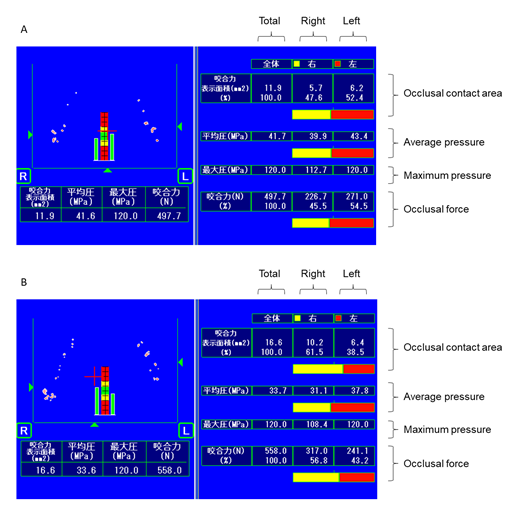
Figure 1: Analysis results of occlusal state using Occluzer. The cross in the figure on the left indicates occlusal balance. A: stable group, B: unstable group.
Fabrication of custom mouthguards
Custom mouthguards were fabricated using a 2.0-mm-thick thermoplastic sheet (Sports Mouthguard; Keystone Industries, Cherry Hill, NJ) and a pressure molding machine (Model Capture Try; Shofu Inc., Kyoto, Japan). The amount of occlusal elevation was within the freeway space and was adjusted so that all teeth were in even contact with light clenching [1,5,7,8]. Occlusal contact when wearing a mouthguard was confirmed by occlusal examination involving the use of blue silicone (Bite Eye; GC Inc., Tokyo).
Physical fitness test
The physical fitness test consisted of 8 items evaluating agility, explosive power, muscle strength, jumping ability, and flexibility, namely, step 50, pro-agility, the three-cone drill, the medicine ball scoop throw, the vertical jump, back muscle strength, spread legs, and prone upper body arched. These 8 items are described below.
Step 50
From starting point A, cones are placed at points 5 m in front, to the left, and to the right (B, C, D) as well as 6 m in front (E) of the participant. Participants start from cone A and the time it takes to reach cone E in order from i to ix is measured (Figure 2).
Pro-agility
Cones are placed at points 5 m to the left and to the right of the center line (A, B). Participants start from the center line and the time it takes to reach the center line in the order of steps i to iii is measured (Figure 3).
Three-cone drill
Three cones are placed in an L shape at 5-m intervals (A, B, C). Participants start from cone A and the time it takes to return to cone A in order from i to vi is measured (Figure 4).
Medicine ball scoop throw
Participants line up their toes on the starting line, hold a 3-kg medicine ball in both hands, and throw it underhanded as far as they can. The distance from the starting line to the landing point of the ball is measured.
Vertical jump
Participants wrap the belt of a digital vertical-jump measuring device (Jump MD TKK5406; Takei Scientific Instruments Co., Ltd., Niigata, Japan) around their waist and stand on the mat. From a squat position with their knees bent, they jump straight up with their hands on their hips. The measurement value displayed on the belt based on the height of the waist in the standing position before jumping as the reference (0 cm) is recorded.
Back muscle strength
Participants stand on the platform of a back muscle strength meter (TKK5002; Takei Scientific Instruments Co., Ltd.) with their feet approximately 15 cm apart and the base of the chain at the midpoint between their toes and heels. They grip the handle while keeping their knee joints straight, straighten their back, and adjust the length of the chain so that their upper body leans forward 30 degrees. The measured value displayed when they raise their upper body without bending knees for about 3 s is recorded.
Spread legs
Participants sit with their legs wide apart to the left and right, and the distance between their heels is measured.
Prone upper body arched
Participants lie prone with their hands behind their hips. They gently bend their upper body, and the distance from the floor to their chin when it is maximally bent is recorded.
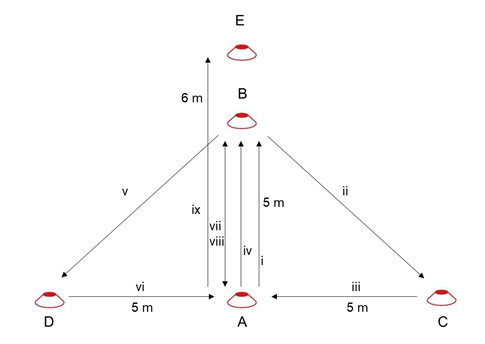
Figure 2: Step 50. i: Dash from A to B. ii: Back cross-step from B to C. iii: Side-step from C to A. iv: Dash from A to B. v: Back cross-step from B to D. vi: Side-step from D to A. vii: Dash from A to B. viii: Running backwards from B to A. ix: Dash from A to E.
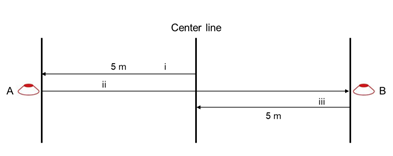
Figure 3: Pro-agility. i: Dash from the center line to A. ii: Change direction and dash from A to B. iii: Dash from B to the center line.
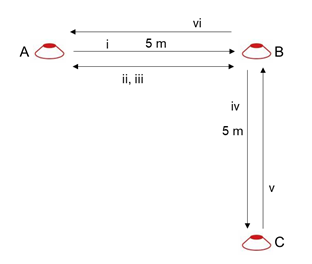
Figure 4: Three-cone drill. i: Dash from A to B. ii: Dash from B to A. iii: Dash from A to B. iv: Dash from B to C. v: Go around the cone at C then dash to B. vi: Go around the cone at B and then dash to A.
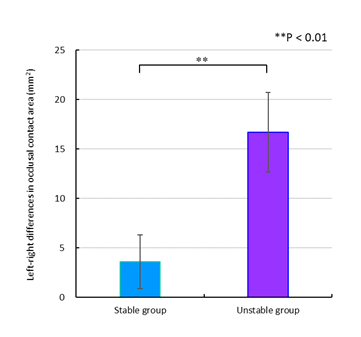
Figure 5: Comparison of left–right differences in occlusal contact area between the stable and unstable groups.
Statistical analysis
Statistical analysis was performed using IBM SPSS ver. 24.0 (SPSS Japan Inc., Tokyo) and the level of significance was set at P < 0.05. The Shapiro–Wilk test was used to test normality, and the Levene test was used to test homogeneity of variance.
The left–right difference in occlusal contact area between the stable and unstable groups was analyzed using Student’s t-test because both levels showed normality and homoscedasticity.
The scores of each physical fitness test were analyzed using a split plot design, with occlusal balance and mouthguard wearing as factors. If an interaction was observed, analysis was performed using a paired t-test or Student’s t-test for each factor.
Results
Figure 5 shows a comparison of the left–right differences in occlusal contact area between the stable and unstable groups. The left–right difference in occlusal contact area was significantly smaller in the stable group than in the unstable group (P < 0.01).
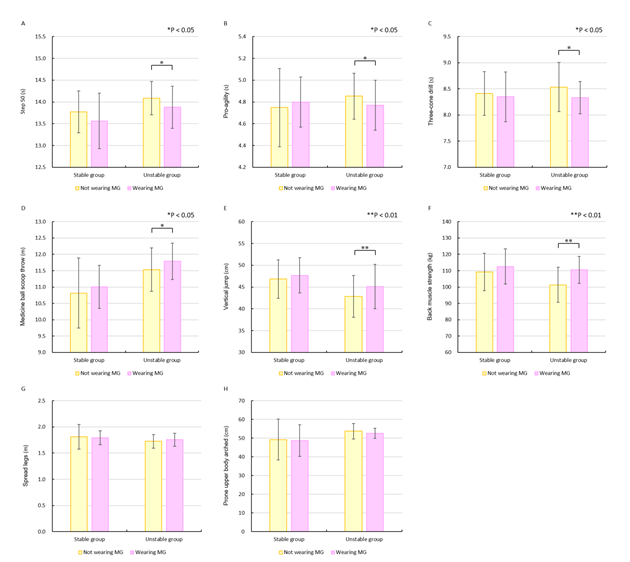
Figure 6: Comparison of test scores based on occlusal balance and mouthguard (MG) factors. A: Step 50, B: Pro-agility, C: Three-cone drill, D: Medicine ball scoop throw, E: Vertical jump, F: Back muscle strength, G: Spread legs, H: Prone upper body arched
Figure 6 shows a comparison of physical fitness test scores based on occlusal balance and mouthguard wearing factors.
Statistical analysis using a split plot design revealed that the interaction for step 50 and three-cone drill was significant, so tests were conducted for each factor. The results of the paired t-test showed that in the unstable group, the score improved significantly when a mouthguard was worn than when it was not (P < 0.05). In contrast, no difference due to wearing a mouthguard was observed in the stable group. Student’s t-test results showed no significant differences between the stable and unstable groups.
Significant differences in pro-agility, the medicine ball scoop throw, the vertical jump, and back muscle strength were due to only the mouthguard factor. In the unstable group, these scores were significantly improved when the mouthguard was worn (P < 0.05, P < 0.01). In the stable group, no difference due to wearing a mouthguard was observed. Additionally, no significant differences were observed between the stable and unstable groups.
The factors of occlusal balance and mouthguard wearing and their interactions were not significant for spread legs and prone upper body arched. No differences were observed due to occlusal balance or mouthguard wearing.
Discussion
The results of this study revealed that the effect of wearing a mouthguard on handball players’ physical fitness test scores differed depending on occlusal balance, and that the influence differed depending on the test items. Therefore, the null hypothesis was rejected.
There were two main reasons for choosing handball players as participants in this study. First, the team to which the players belong regularly subjects them to physical fitness tests to evaluate their agility, explosive power, muscle strength, jumping ability, flexibility, and so on, and it uses these tests in their training. Second, during a handball game, players must make repeated movements that involve changes in direction. Previous studies have revealed that agility is influenced by occlusal balance [3,4]; therefore, it was predicted that the effect of the mouthguard intervention would be significant. Furthermore, the state of occlusal contact can affect the stability of the trunk or the sway of the center of gravity [1,5,7]. Accordingly, it was inferred that equalization of the occlusal contact state by wearing a mouthguard contributed to the improvement of postural control function, which had an impact on physical performance mainly through changing direction.
The physical fitness test conducted in this study focused on agility, explosive power, muscle strength, jumping ability, and flexibility, with items such as running ability and throwing ability also having an influence. Specifically, step 50 evaluates agility and includes elements of explosive power and running ability. Pro-agility and three-cone drills focus mainly on agility and explosive power and include elements of running ability. The medicine ball scoop throw relies mainly on explosive power, muscle strength, and core strength, and includes elements of throwing ability. The vertical jump is based mainly on explosive power, lower limb muscle strength, and jumping power, and includes elements of trunk stability. Back muscle strength is an item that evaluates the muscle strength of the trunk and hip joints. Spread legs is an item that evaluates the flexibility of the hip joint and hamstrings, while prone upper body arched is an item that evaluates the flexibility of the dorsal muscles. These physical abilities are all important factors in handball games, and team trainers create training programs for individual players by comparing the scores of these tests over time.
When exerting muscle strength or changing the direction of the body, a fixation source is required in each part of the body [10]. The main source of fixation within the body is the trunk [11,12], and occlusion is one element that supports trunk stability [9]. In this study, the scores for step 50, pro-agility, the three-cone drill, the medicine ball scoop throw, the vertical jump, and back muscle strength were significantly better when wearing a mouthguard, but only in the unstable group. Step 50, pro-agility, and three-cone drills consist mainly of movements that involve changes in direction, and thus require stability of the trunk. Medicine ball scoop throws and vertical jumps stabilize the trunk and provide instantaneous muscular strength. Back muscle strength is a movement that uses the strength of the trunk extensor muscles and hip joints. These tests evaluate agility, explosive power, muscle strength, and jumping ability, and are indicators for evaluating quick changes in the direction of the body as well as muscle strength. Clenching during exercise occurs during cutting motions or when maximal muscle strength is exerted, and is thought to occur temporarily rather than continuously. This is because persistent clenching reduces spinal range of motion [6,9], which depends primarily on the range of motion of the lumbar and sacral vertebrae. The area around the lumbar vertebrae consists of a group of muscles that originate and terminate deep in the trunk, and the movement of the sacral vertebrae is linked to the tilt of the pelvis and the movement of the hip joints [13,14]. From this, it can be inferred that if clenching persists during exercise, smooth movement will be hindered. In addition, the masseter, temporalis, sternocleidomastoid, and neck muscles, which are fascially linked to the trunk muscles, are activated during clenching [11,12,15-17], suggesting that clenching works to stabilize the trunk. These effects probably had an effect on the physical fitness test scores. Occlusal balance affects the displacement of the center of foot pressure, and people with good occlusal balance have better postural control function [5,7,18-22], and correcting occlusal balance by wearing an intraoral appliance can reduce the displacement of the center of foot pressure [1,5]. Unsurprisingly, in this study, the effect of wearing a mouthguard on the test score was observed only in the unstable group and was limited to items that required changes in the direction of the body (i.e., movements that required core stability) and events that required maximum muscle strength. In contrast, spread legs and prone upper body arched are items that evaluate flexibility (i.e., trunk flexion), which is the action of loosening muscles and joints, and thus clenching may not have had a positive effect.
Based on previous research showing that the influence of clenching on sports performance differs between conscious and unconscious conditions [23], we did not give instructions on clenching during the physical fitness test conducted in this study, and this can be considered a limitation of this study. In general, the effects on the body of wearing a mouthguard include a mixture of advantages such as stabilizing jaw position and a feeling of being protected against impacts as well as disadvantages such as impaired speech, difficulty breathing, and the sensation of a foreign body. Although there are many factors related to oral sensation that make wearing a mouthguard a disadvantageous, this study found that some items improved test scores. This suggests that instantaneous clenching or sustained clenching may have occurred during the test. To confirm when clenching actually occurs, electromyographic analysis and video analysis would be useful. Although there is a concern that attaching an electromyograph and fixing it by taping may have some effect on exercise movements, it is important to consider this effect in the future.
Conclusion
The results of this study revealed that the effect of wearing a mouthguard on a handball player’s physical ability is influenced by the player’s occlusal contact state. In other words, in athletes with poor occlusal contact, improving occlusal contact by wearing a mouthguard had a positive impact on physical performance, mainly in terms of agility, explosive power, muscle strength, and jumping ability. However, for athletes who already had good occlusal contact, wearing a mouthguard did not affect their physical performance.
Data availability
The datasets collected and/or analyzed during the current study are available from the corresponding author on reasonable request.
Acknowledgments
This work was supported by JSPS KAKENHI Grant Number JP23K10617 and the Nippon Dental University Intramural Research Fund (NDU Grants N-21004).
Conflicts of interest statement
The authors have no conflicts of interest relevant to this article.
References
- Takahashi M, Bando Y, Fukui T, et al. Equalization of the occlusal state by wearing a mouthguard contributes to improving postural control function. Appl Sci 13 (2023): 4342.
- Hirao A, Murata S, Kubo A, et al. Association between occlusal force and physical functions in preschool children: a comparison of males and females. J Phys Ther Sci 27 (2015): 3729-3732.
- Bando Y, Takahashi M, Kitayama Y. Relationship between oral function and motor ability of top Japanese junior badminton players: part 1 examination of occlusal force by Dental Prescale. J Sports Dent 21 (2018): 23-30.
- Takahashi M, Bando Y. Relationship between occlusal balance and agility in Japanese elite female junior badminton players. Int J Sports Dent 11 (2018): 34-42.
- Bando Y, Takahashi M, Fukui T, et al. Relationship between occlusal state and posture control function of trampoline gymnasts. J Sports Dent 23 (2019): 14-20.
- Takahashi M, Bando Y, Fukui T, et al. Effect of clenching on spinal alignment in normal adults. Int J Dent Oral Health 8 (2021): 386.
- Takahashi M, Bando Y, Fukui T, et al. Straight jump landing position of trampoline gymnasts with stable occlusal balance reflects standing postural control function. Appl Sci 13 (2023): 6689.
- Takahashi M, Bando Y, Fukui T, et al. Influence of occlusion on flight time in trampoline competition. Int J Dent Oral Health 9 (2023): 405.
- Takahashi M, Bando Y. Influence of voluntary clenching on spinal range of motion depends on occlusal contact state. APE (2023): in press.
- Boroojerdi B, Battaglia F, Muellbacher W, et al. Voluntary teeth clenching facilitates human motor system excitability. Clin Neurophysiol 111 (2000): 988-993.
- Thomas WM. Anatomy trains. (3rd ed), Superficial front line, pp:107-126, Lateral line, pp:127-144, Deep front line, pp: 201-228. Tokyo: Igaku-shoin (2013).
- Robert S, Amanda B. Fascia in sport and movement. Anatomy trains in motion, pp:47-62. Tokyo: Round flat (2019).
- Kapandji IA. Capandy Physiologie articulaire III. pp:28-29, 212. Tokyo: Ishiyaku (1986).
- Bergmark A. Stability of the lumbar spine: a study in mechanical engineering. Acta Orthopaedica Scandinavica 230 (1989): 1-254.
- Davis PL. Electromyographic study of superficial neck muscles in mandibular function. J Dent Res 58 (1979): 537-538.
- Kohno S, Yoshida K, Kobayashi H, et al. The EMG activities of the sternocleidomastoid muscle during occlusal function. Jpn Prosthodont Soc 31 (1987): 764-769.
- Mitani Y, Morikita I. Correlation between sagittal plane alignment of the lumbosacral spine and trunk muscle strength and leg muscle flexibility in a static, upright position. Rigakuryoho Kagaku 23 (2008): 35-38.
- Bracco P, Deregibus A, Piscetta R, et al. Observations on the correlation between posture and jaw position: a pilot study. Cranio 16 (1998): 252-258.
- Gangloff P, Louis JP, Perrin PP. Dental occlusion modifies gaze and posture stabilization in human subjects. Neuroscience Letters 293 (2000): 203-206.
- Bracco P, Deregibus A, Piscetta R. Effects of different jaw relations on postural stability in human subjects. Neurosci Lett 356 (2004): 228-230.
- Eunse P, Gregor S, John PS. Functional synergies underlying control of upright posture during changes in head orientation. Plos One 7 (2012): e41583.
- Alghadir AH, Zafar H, Iqbal ZA. Effect of three different jaw positions on postural stability during standing. Funct Neurol 30 (2015): 53-57.
- Ishioka K, Kohno S, Sato Y. Activities of masticatory muscles observed during sustained body movements and phasic movements. Mandibular motor function and EMG 10 (1992): 105-110.


 Impact Factor: * 3.1
Impact Factor: * 3.1 Acceptance Rate: 76.66%
Acceptance Rate: 76.66%  Time to first decision: 10.4 days
Time to first decision: 10.4 days  Time from article received to acceptance: 2-3 weeks
Time from article received to acceptance: 2-3 weeks 